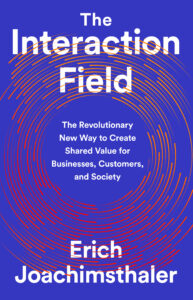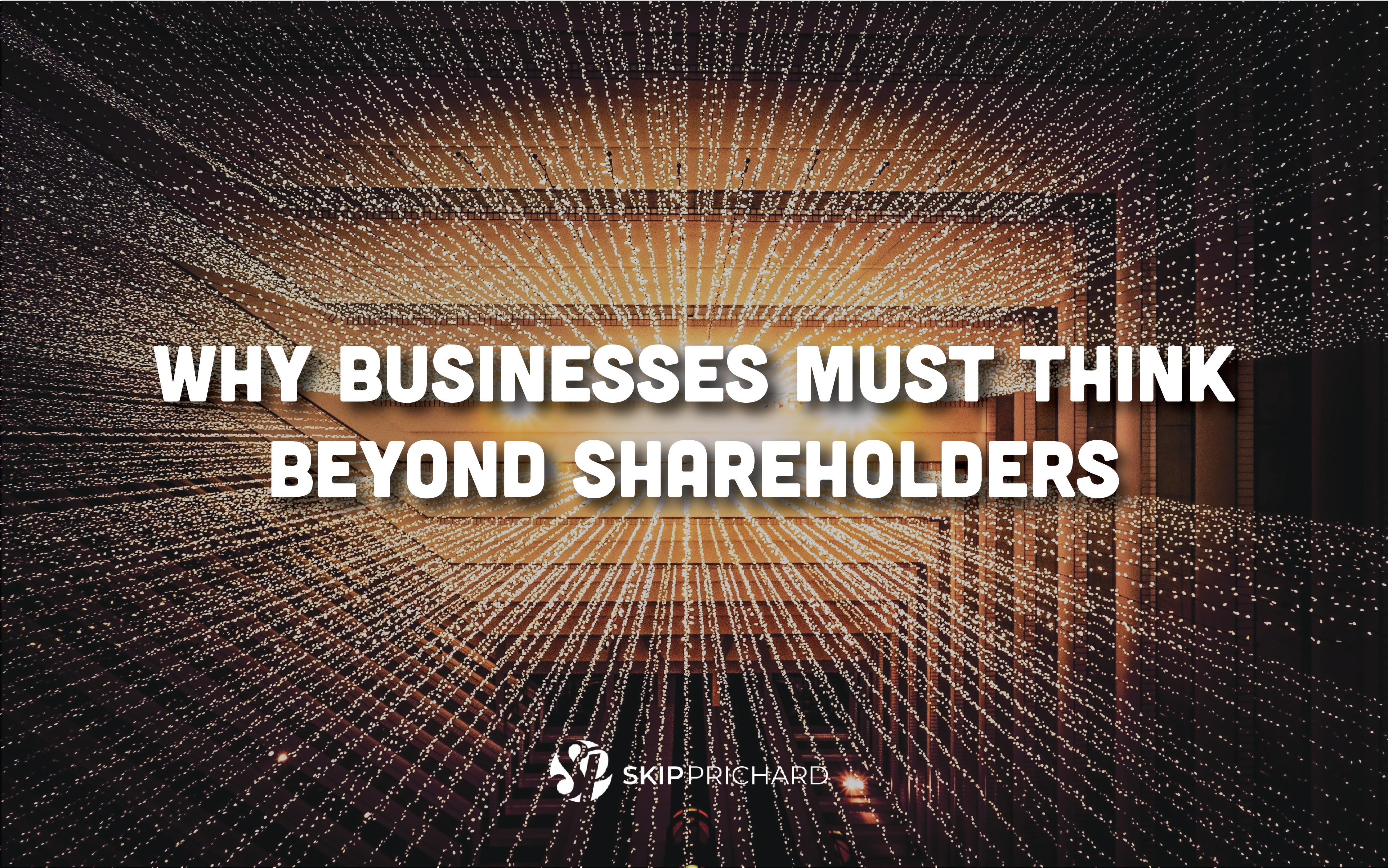The Future of Business
In The Interaction Field: The Revolutionary New Way to Create Shared Value for Businesses, Customers, and Society, the author argues that the future of business is about creating value for everyone, not just shareholders. Erich Joachimsthaler offers a new model, called interaction field companies, to generate and benefit from data exchanges among multiple groups. The book offers a fascinating view into a new type of organization that is just emerging. Erich is the founder of VIVALDI, a global strategy and transformation firm. After reading the book, we talked about this new perspective.
A long taught fundamental belief is that “a corporation exists solely for the benefit of shareholders.” Why is that changing?
It is a long-taught fundamental belief, but that does not make it right. There is a dialogue in the novel The Sun Also Rises by Ernest Hemingway from 1926 where he asks: “How did you go bankrupt? Two ways: Gradually, then suddenly.” And so it is with the shareholder value maximization principle, the end has been coming for a long time, gradually then suddenly.
We live in a finite world, called Earth. And we have populated it gradually over centuries, then suddenly. Global population has doubled in the past 50 years and is forecast to grow to 11 billion by the end of the century. It took until 1804 for the global population to reach 1 billion. The most recent addition of 1 billion people took just 12 years.[1]
We are also increasingly more connected, first gradually, then suddenly. Never in the history have so many technologies matured at the same time from social, mobile, cloud, artificial intelligence, sensors, quantum computing, and more. The combinatorial effects of these technologies have suddenly accelerated progress exponentially toward the hyperconnected world, we live in today.
These two factors have made everyone aware that maximizing shareholder value at the cost of everything and everyone else is a bankrupt enterprise.
How do companies best shift in order to thrive in the midst of the new demands?
It takes two steps for companies to shift. One is about mindset. We need to rethink the nature of capitalism, the role of the firm in society and the role of brands in consumers’ daily life. This mindset shift has already taken place here and there. The declaration of over 180 CEOs who are part of the Business Roundtable that redefines the purpose of the corporation is just one example.
The second step is to put the mindset in practice. There needs to be a framework and model that leaders can follow, an operating model, so to speak. Until now this framework and model did not exist, and that’s why progress has been limited. It is my opinion that the interaction field model is the answer.
What are some of the major differences between a value chain company, a platform company, and an interaction field company?
Platform businesses are a new economic model that replaces or augments the traditional value chain company that was the dominant model in the first, second and third industrial revolution. The fourth industrial revolution we live now is enabled in part by the platform-based business models. A transitional model is the platform company.
Platform businesses, like Uber and Airbnb, have already served a useful purpose for more than a decade now. They facilitate transactions, remove frictions, solve consumer problems, and because they are asset light, they can grow and scale rapidly. However, in many cases the platform model primarily serves a narrow set of customer needs, get a ride, rent a spare room, find a dog walker, or find an open table for a restaurant, home delivery of groceries or anything else, etc.
Most platforms are short-lived because they are merely self-serving, and so have been value-chain companies. They create wealth for the platform orchestrator, the value chain owner and shareholders. What is needed now, is a business model and operating model that solves complex intractable challenges and problems, not just at the consumer level, but at the industry or category level and societal level. What is needed is a model that creates shared value, not shareholder value, a model that replaces the old notion of competition and disruption, and instead fosters collaboration, engagement and participation.
Consumers today are tired of marketers and being constantly marketed to. They are no longer content to be objects toward which products or brands are positioned and targeted. That worked in the need-fulfillment world where consumers were in search of products that satisfied their needs of a car, a washing machine, a house. Today, consumers don’t need a car, they want companies and brands to solve their mobility needs.
Consumers can choose from 155 meal-kit solutions like Blue Apron or Hello Fresh (now part of Nestle) and 175 mattress companies like Casper by moving a finger 1 ½ inches in either direction on their mobile phone. Consumers also expect to be active participants in value creation as they engage, participate, share, contribute, comment, benefit and learn. They want more, their expectations are constantly rising. If Amazon delivers to my doorsteps within an hour, why can’t Nike or 1800 Flowers? Traditional customer experience management will not cut it anymore. The only model that can solve for all these challenges is the interaction field model.
Talk some more about the promise of the interaction field model.
In The Interaction Field I describe a broad range of companies and industries. I researched over 200 companies and brands in depth and choose a few dozen as exemplars of what challenges, problems, needs and wants these companies can solve for at the consumer, industry and societal level.
In South Africa, Discovery Health, a health insurance company built a system that involves consumers taking active part in their health by focus on three factors – smoking, nutrition, and physical activity that impact four diseases: diabetes, cancer, heart disease, and lung disease. By building a large, open interaction field of many participants from technology companies like Apple (you get a free Apple watch) to fitness companies like adidas or the local gym, to the local grocery store where you can get healthy food, Discovery Health delivers undeniable benefits to everyone: providers like doctors or hospitals that reduce costs because of lower hospital admittance, and patients. The motto is: stay healthy, pay less, and live longer. On average, life expectancy is eight years longer which helps even payors like the insurance company that has longer paying members that need less care. Overall, a healthier society because of reduced healthcare burden.
Ant Financial is the largest and most successful fintech company in the world. About 40% of its business is lending money, sometimes just a few bucks, offered on a click in seconds primarily to consumers who don’t have access to loans from the traditional banks. It offers many financial products such as wealth management or insurance products that typically only are available to the privileged class of rich Chinese. It democratizes investing to all people, while lowering risks for banks. It even offers its technology to competitors which solves some major industry problems. Over 100 banks, 60 insurers and 40 wealth management companies and brokerages use the Ant technology now, over 40 million service providers are now part of the interaction field for this six-year-old company.
Kloeckner Metal is a metals distributor to small welding shops or large companies like Volkswagen in Germany. The industry’s major problem is that it isn’t very digital. Most transactions take place via telephone and fax. It is also an industry that is highly inefficient, going from one restructuring to save costs to another round of the same for many years. Major inventory problems where, for example, a large steel beam sits idle waiting before it can be transported and installed to build a high-rise office building costs the steel company, the distributor or the customer. This relatively small distributor, Kloeckner, built an interaction field model that helped solve some of these massive industry problems for the benefit of its customers, the industry, and a more profitable business for themselves.
In the book, I show how interaction field companies solve problems in the agricultural field (John Deere), the car industry (Tesla or Waymo), healthcare (Flatiron Health), consumer goods (Mars Petcare), appliances (Haier), toys (LEGO) and so much more.
Share an example or two of interaction field companies and how they are making a difference.
Flatiron Health is an example that shows that an interaction field company can be built even in complex industries such as healthcare, where patients share incredibly sensitive information but do so for the greater benefits of everyone. Flatiron Health is now a Roche Pharma company that brings together patients, care providers in cancer hospitals, and even competing pharmaceutical companies and regulators like the Food and Drug Administration. Over two million cancer patients, and 2,500 clinicians in 800 unique sites of care share “research-grade” data with the larger healthcare and pharmaceutical community regulatory bodies such as the FDA or the National Cancer Institute. Competitors participate including 14 of the top 15 life sciences companies. The success of Flatiron Health has cut significantly the average years of FDA approval of new therapeutic solutions, cut the cost of care at cancer hospitals, and has led to much more effective treatment of cancer patients, saving lives.
How do different traditional value chain companies, who read your book, and want to change best start that process?
In the book, I describe a four-step process that is now a proven methodology of how to become an interaction field company. The four steps are: framing, designing, building and sharing.
 The starting point is framing of what you are solving for, at the consumer level, the industry level and level of society. This framing process is an important one because it requires recognition that everything these days is interconnected and linked.
The starting point is framing of what you are solving for, at the consumer level, the industry level and level of society. This framing process is an important one because it requires recognition that everything these days is interconnected and linked.
Tesla isn’t just solving for reducing C02 emissions or greenhouse gas emissions by producing electric cars, it also reduces the cost of car ownership that stands at $9,000 right now to potentially $2,000 per year. Electric cars have significantly fewer moving parts, about 20 versus 2,000 in a gas-powered car, so there will be a lot less maintenance, and hence lower repair and service revenues for dealers. Teslas are loaded with more sensors and cameras than any other car which increases the value of Autopilot with every mile driven by a Tesla driver, which in turn increases the safety of the car. Over 37,000 people die in the US alone on highways every year. If you ask Tesla, they don’t even see themselves as merely a car company.
In short, framing what you are solving is the best way to start the process. Are you merely selling the perceptions that your car is better, faster or cheaper? Are you merely creating the perception that you connect more deeply emotionally with certain types of drivers? Are you merely selling brand relevance or brand love, a thin veneer of feelings and emotions? Or are you really solving some of the major challenges and problems that we as people, consumers, as an industry or society really face?
That’s where you need to start the process. The four steps are: framing – what new problems and intractable challenges you are solving for customers, industry and society, designing – how create interactions, architecture and governance in such a way that enables collaboration, engagement and participation of everyone, building – how to build a system that is open, inclusive and comprehensive and that deeply integrates in the lives of interaction field participants, and finally sharing – how to not just extract value and capture value, but also share out value.
What leadership challenges are emerging for leaders in this environment?
The biggest leadership challenge is to create the future while managing the present across the entire organization. It is easy to charge a team or group of executive or a division and venture forward with future projects. Nearly every firm has now started a venturing group, set aside hundreds of millions of dollars to invest in startups or grow them. We have heard the slogans: bring Silicon Valley inside, create a startup culture, let’s create speed boats that will ultimately help turn the tanker, let’s create an ambidextrous organization, let 1,000 flowers bloom, fail forward fast, experiment and be agile, let’s partner with some of the coolest tech companies, etc.
All these efforts are merely blind-siding the senior leadership team, the board or shareholders to the real challenges the company faces. In my book I describe how leaders have been able to evolve a traditional organization, incumbents (dare I say: corporates) with a well-oiled and highly-optimized value chain and create an interaction field company.
The real challenges are to get the entire company engaged, not just the leadership team, but managers and the front-line workers who still repair metering devices for customers while the top thinks about a new energy future, for example. It requires orchestrating an entirely new mindset from competition and disruption to collaboration, engagement and participation. It requires creation of a new operating model and new company structure, less hierarchical and much more of a network that enables collective engagement of everyone, and it requires changing how we measure what we strive for. Are we merely focused on value creation for the company and customers while issuing another press release about our sustainability efforts, or do we create shared value, prosperity, and wealth for ecosystem partners and others as well? In short, shared value for everyone, not shareholder value!
For more information, see The Interaction Field: The Revolutionary New Way to Create Shared Value for Businesses, Customers, and Society.
[1] http://reports.weforum.org/digital-transformation/onward-and-upward-the-transformative-power-of-technology/
Image Credit: Joshua Sortino

